wheel INFINITI QX50 2020 Owner's Manual
[x] Cancel search | Manufacturer: INFINITI, Model Year: 2020, Model line: QX50, Model: INFINITI QX50 2020Pages: 580, PDF Size: 7.43 MB
Page 517 of 580
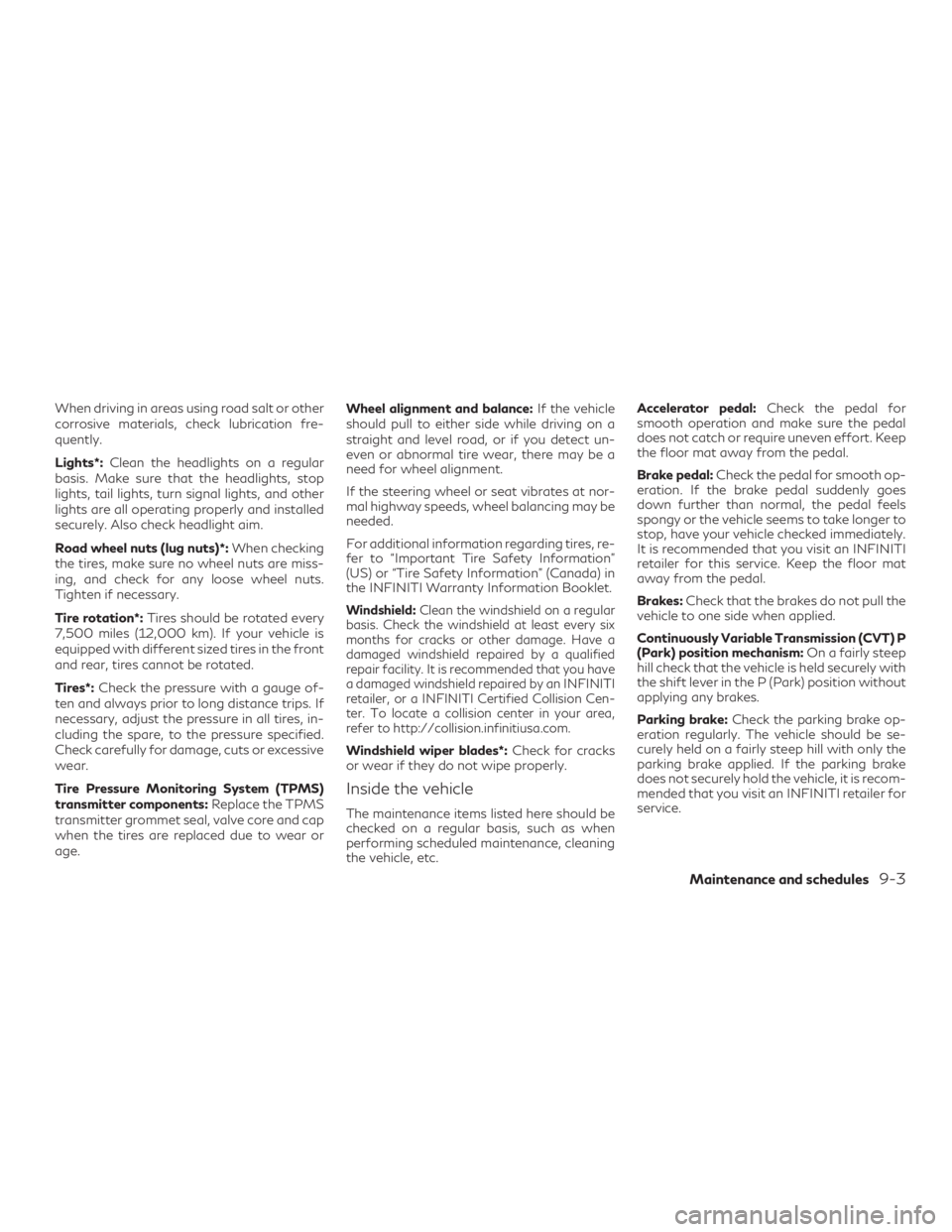
When driving in areas using road salt or other
corrosive materials, check lubrication fre-
quently.
Lights*:Clean the headlights on a regular
basis. Make sure that the headlights, stop
lights, tail lights, turn signal lights, and other
lights are all operating properly and installed
securely. Also check headlight aim.
Road wheel nuts (lug nuts)*: When checking
the tires, make sure no wheel nuts are miss-
ing, and check for any loose wheel nuts.
Tighten if necessary.
Tire rotation*: Tires should be rotated every
7,500 miles (12,000 km). If your vehicle is
equipped with different sized tires in the front
and rear, tires cannot be rotated.
Tires*: Check the pressure with a gauge of-
ten and always prior to long distance trips. If
necessary, adjust the pressure in all tires, in-
cluding the spare, to the pressure specified.
Check carefully for damage, cuts or excessive
wear.
Tire Pressure Monitoring System (TPMS)
transmitter components: Replace the TPMS
transmitter grommet seal, valve core and cap
when the tires are replaced due to wear or
age. Wheel alignment and balance:
If the vehicle
should pull to either side while driving on a
straight and level road, or if you detect un-
even or abnormal tire wear, there may be a
need for wheel alignment.
If the steering wheel or seat vibrates at nor-
mal highway speeds, wheel balancing may be
needed.
For additional information regarding tires, re-
fer to “Important Tire Safety Information”
(US) or “Tire Safety Information” (Canada) in
the INFINITI Warranty Information Booklet.
Windshield: Clean the windshield on a regular
basis. Check the windshield at least every six
months for cracks or other damage. Have a
damaged windshield repaired by a qualified
repair facility. It is recommended that you have
a damaged windshield repaired by an INFINITI
retailer, or a INFINITI Certified Collision Cen-
ter. To locate a collision center in your area,
refer to http://collision.infinitiusa.com.
Windshield wiper blades*: Check for cracks
or wear if they do not wipe properly.
Inside the vehicle
The maintenance items listed here should be
checked on a regular basis, such as when
performing scheduled maintenance, cleaning
the vehicle, etc. Accelerator pedal:
Check the pedal for
smooth operation and make sure the pedal
does not catch or require uneven effort. Keep
the floor mat away from the pedal.
Brake pedal: Check the pedal for smooth op-
eration. If the brake pedal suddenly goes
down further than normal, the pedal feels
spongy or the vehicle seems to take longer to
stop, have your vehicle checked immediately.
It is recommended that you visit an INFINITI
retailer for this service. Keep the floor mat
away from the pedal.
Brakes: Check that the brakes do not pull the
vehicle to one side when applied.
Continuously Variable Transmission (CVT) P
(Park) position mechanism: On a fairly steep
hill check that the vehicle is held securely with
the shift lever in the P (Park) position without
applying any brakes.
Parking brake: Check the parking brake op-
eration regularly. The vehicle should be se-
curely held on a fairly steep hill with only the
parking brake applied. If the parking brake
does not securely hold the vehicle, it is recom-
mended that you visit an INFINITI retailer for
service.
Maintenance and schedules9-3
Page 518 of 580
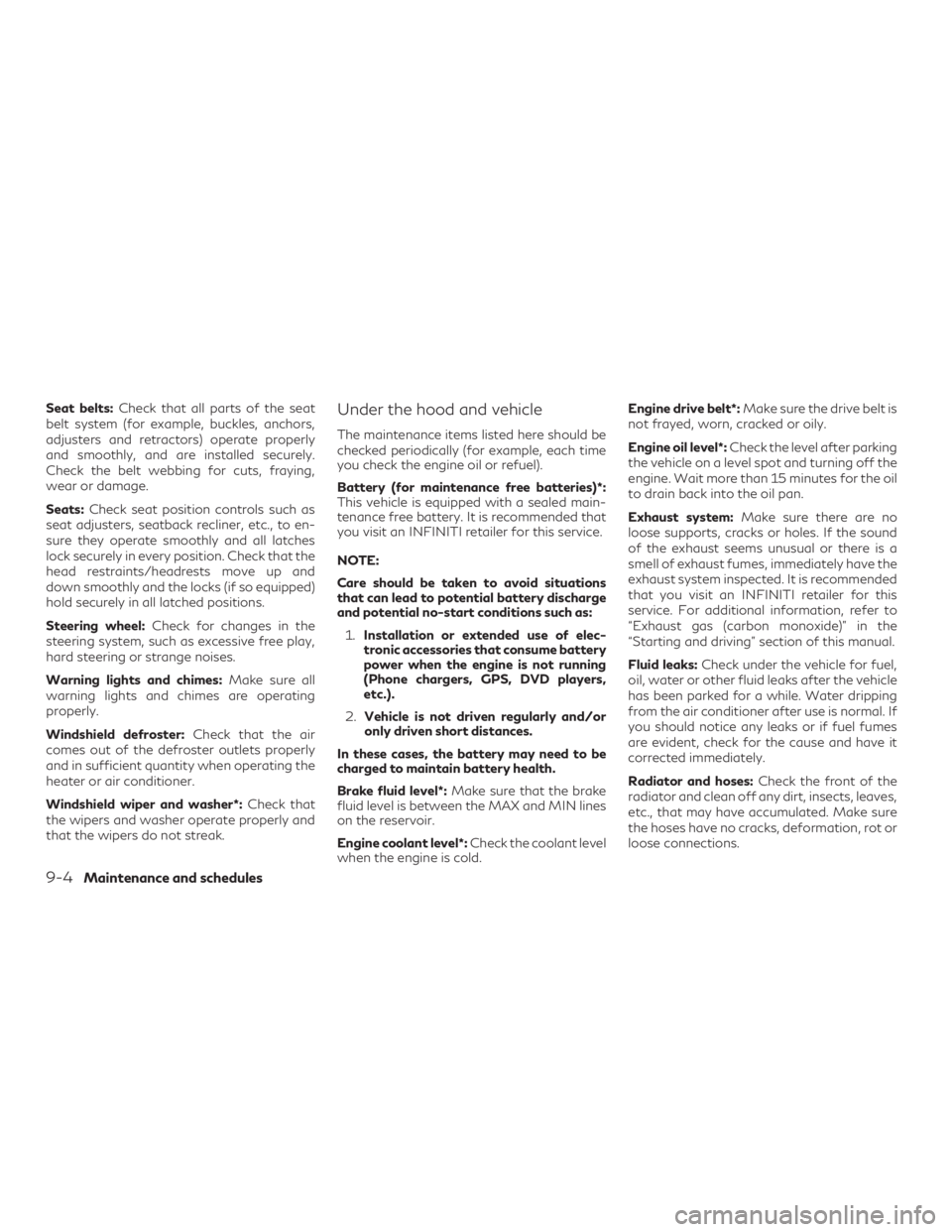
Seat belts:Check that all parts of the seat
belt system (for example, buckles, anchors,
adjusters and retractors) operate properly
and smoothly, and are installed securely.
Check the belt webbing for cuts, fraying,
wear or damage.
Seats: Check seat position controls such as
seat adjusters, seatback recliner, etc., to en-
sure they operate smoothly and all latches
lock securely in every position. Check that the
head restraints/headrests move up and
down smoothly and the locks (if so equipped)
hold securely in all latched positions.
Steering wheel: Check for changes in the
steering system, such as excessive free play,
hard steering or strange noises.
Warning lights and chimes: Make sure all
warning lights and chimes are operating
properly.
Windshield defroster: Check that the air
comes out of the defroster outlets properly
and in sufficient quantity when operating the
heater or air conditioner.
Windshield wiper and washer*: Check that
the wipers and washer operate properly and
that the wipers do not streak.Under the hood and vehicle
The maintenance items listed here should be
checked periodically (for example, each time
you check the engine oil or refuel).
Battery (for maintenance free batteries)*:
This vehicle is equipped with a sealed main-
tenance free battery. It is recommended that
you visit an INFINITI retailer for this service.
NOTE:
Care should be taken to avoid situations
that can lead to potential battery discharge
and potential no-start conditions such as:
1. Installation or extended use of elec-
tronic accessories that consume battery
power when the engine is not running
(Phone chargers, GPS, DVD players,
etc.).
2. Vehicle is not driven regularly and/or
only driven short distances.
In these cases, the battery may need to be
charged to maintain battery health.
Brake fluid level*: Make sure that the brake
fluid level is between the MAX and MIN lines
on the reservoir.
Engine coolant level*: Check the coolant level
when the engine is cold. Engine drive belt*:
Make sure the drive belt is
not frayed, worn, cracked or oily.
Engine oil level*: Check the level after parking
the vehicle on a level spot and turning off the
engine. Wait more than 15 minutes for the oil
to drain back into the oil pan.
Exhaust system: Make sure there are no
loose supports, cracks or holes. If the sound
of the exhaust seems unusual or there is a
smell of exhaust fumes, immediately have the
exhaust system inspected. It is recommended
that you visit an INFINITI retailer for this
service. For additional information, refer to
“Exhaust gas (carbon monoxide)” in the
“Starting and driving” section of this manual.
Fluid leaks: Check under the vehicle for fuel,
oil, water or other fluid leaks after the vehicle
has been parked for a while. Water dripping
from the air conditioner after use is normal. If
you should notice any leaks or if fuel fumes
are evident, check for the cause and have it
corrected immediately.
Radiator and hoses: Check the front of the
radiator and clean off any dirt, insects, leaves,
etc., that may have accumulated. Make sure
the hoses have no cracks, deformation, rot or
loose connections.
9-4Maintenance and schedules
Page 531 of 580
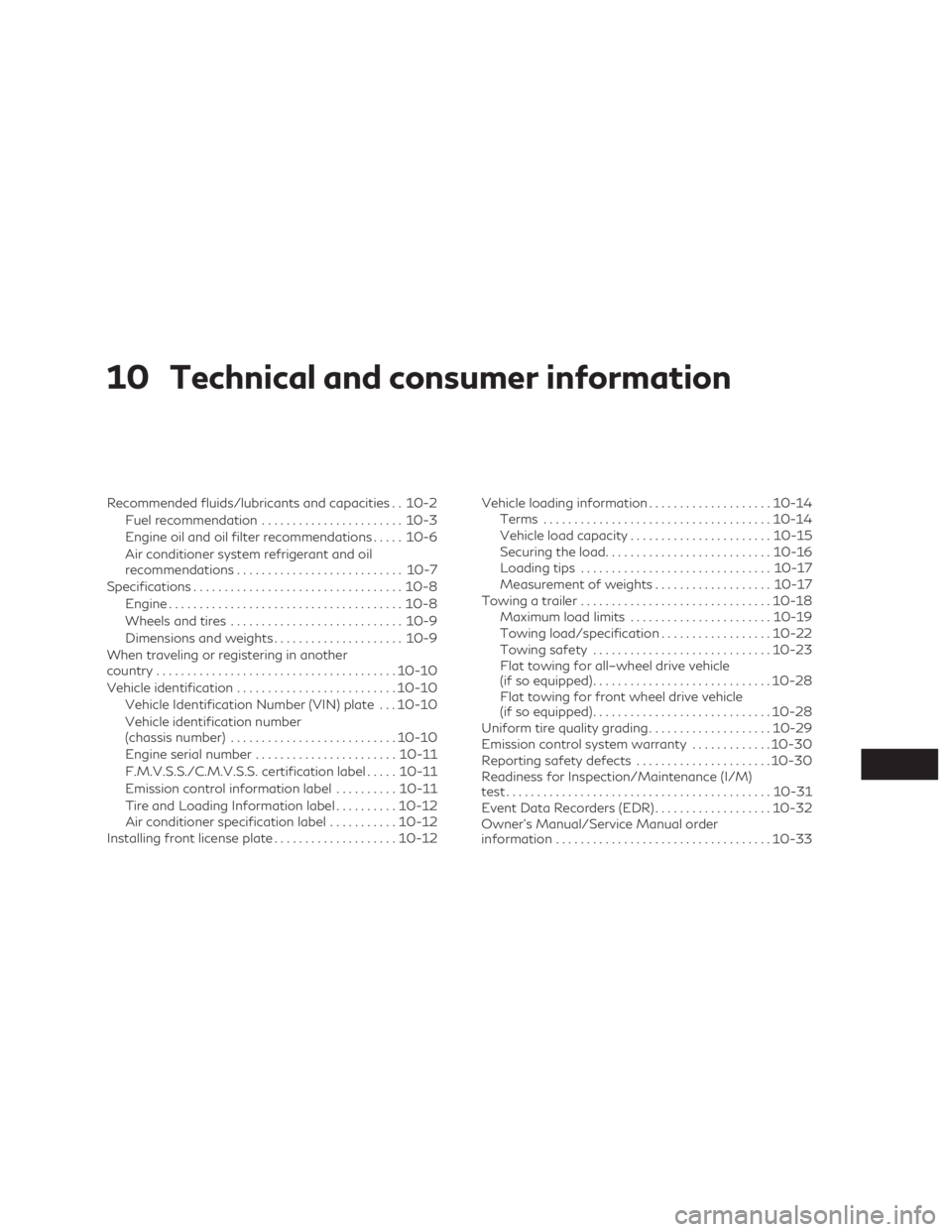
10 Technical and consumer information
Recommended fluids/lubricants and capacities . . 10-2Fuel recommendation ....................... 10-3
Engine oil and oil filter recommendations .....10-6
Air conditioner system refrigerant and oil
recommendations ........................... 10-7
Specifications .................................. 10-8
Engine ...................................... 10-8
Wheels and tires ............................ 10-9
Dimensions and weights .....................10-9
When traveling or registering in another
country ....................................... 10-10
Vehicle identification .......................... 10-10
Vehicle Identification Number (VIN) plate . . . 10-10
Vehicle identification number
(chassis number) ........................... 10-10
Engine serial number ....................... 10-11
F.M.V.S.S./C.M.V.S.S. certification label .....10-11
Emission control information label ..........10-11
Tire and Loading Information label ..........10-12
Air conditioner specification label ...........10-12
Installing front license plate ....................10-12Vehicle loading information
....................10-14
Terms ..................................... 10-14
Vehicle load capacity ....................... 10-15
Securing the load ........................... 10-16
Loading tips ............................... 10-17
Measurement of weights ...................10-17
Towing a trailer ............................... 10-18
Maximum load limits ....................... 10-19
Towing load/specification ..................10-22
Towing safety ............................. 10-23
Flat towing for all–wheel drive vehicle
(if so equipped) ............................. 10-28
Flat towing for front wheel drive vehicle
(if so equipped) ............................. 10-28
Uniform tire quality grading ....................10-29
Emission control system warranty .............10-30
Reporting safety defects ......................10-30
Readiness for Inspection/Maintenance (I/M)
test ........................................... 10-31
Event Data
Recorders (EDR) ................... 10-32
Owner’s Manual/Service Manual order
information ................................... 10-33
Page 539 of 580
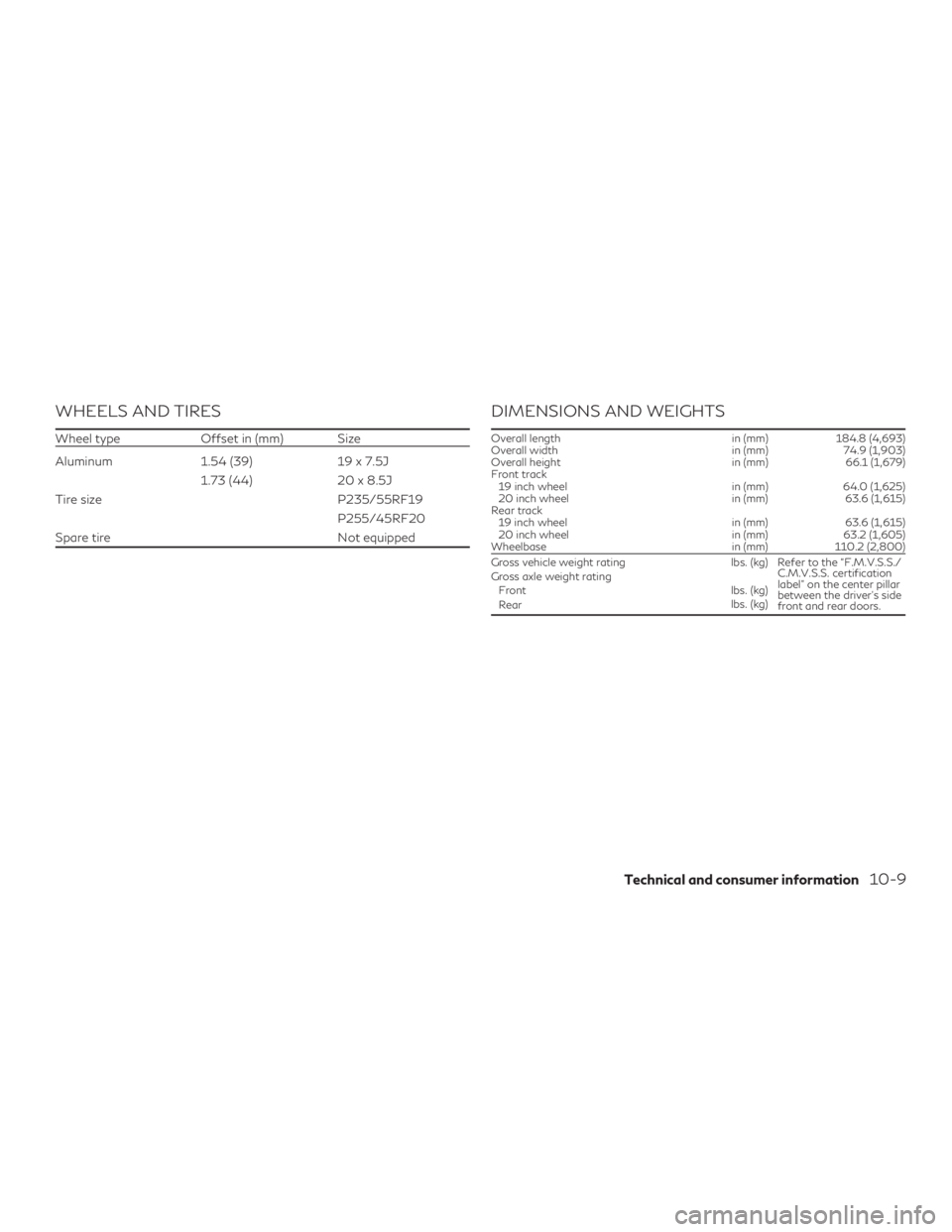
WHEELS AND TIRES
Wheel typeOffset in (mm) Size
Aluminum 1.54 (39)19 x 7.5J
1.73 (44) 20 x 8.5J
Tire size P235/55RF19
P255/45RF20
Spare tire Not equipped
DIMENSIONS AND WEIGHTS
Overall lengthin (mm)184.8 (4,693)
Overall width in (mm)74.9 (1,903)
Overall height in (mm)66.1 (1,679)
Front track 19 inch wheel in (mm)64.0 (1,625)
20 inch wheel in (mm)63.6 (1,615)
Rear track 19 inch wheel in (mm)63.6 (1,615)
20 inch wheel in (mm)63.2 (1,605)
Wheelbase in (mm)110.2 (2,800)
Gross vehicle weight rating lbs. (kg) Refer to the “F.M.V.S.S./
C.M.V.S.S. certification
label” on the center pillar
between the driver’s side
front and rear doors.
Gross axle weight rating
Front lbs. (kg)
Rear lbs. (kg)
Technical and consumer information10-9
Page 547 of 580

WARNING
∙ Properly secure all cargo with ropes orstraps to help prevent it from sliding or
shifting. Do not place cargo higher than
the seatbacks. In a sudden stop or colli-
sion, unsecured cargo could cause per-
sonal injury.
∙ The child restraint top tether strap may be damaged by contact with items in the
cargo area. Secure any items in the cargo
area. Your child could be seriously injured
or killed in a collision if the top tether
strap is damaged.
∙ Do not load your vehicle any heavier than the GVWR or the maximum front and
rear GAWRs. If you do, parts of your ve-
hicle can break, tire damage could occur,
or it can change the way your vehicle
handles. This could result in loss of con-
trol and cause personal injury.
LOADING TIPS
∙ The GVW must not exceed GVWR
or GAWR as specified on the
F.M.V.S.S./C.M.V.S.S. certifica-
tion label.
∙ Do not load the front and rear axle to the GAWR. Doing so will exceed
the GVWR.
WARNING
∙ Properly secure all cargo with ropes or straps to help prevent it
from sliding or shifting. Do not
place cargo higher than the seat-
backs. In a sudden stop or collision,
unsecured cargo could cause per-
sonal injury.
∙ Do not load your vehicle any heavier than the GVWR or the
maximum front and rear GAWRs.
If you do, parts of your vehicle can
break, tire damage could occur, or
it can change the way your vehicle
handles. This could result in loss of
control and cause personal injury. ∙ Overloading not only can shorten
the life of your vehicle and the tire,
but can also cause unsafe vehicle
handling and longer braking dis-
tances. This may cause a prema-
ture tire failure which could result
in a serious accident and personal
injury. Failures caused by over-
loading are not covered by the ve-
hicle’s warranty.MEASUREMENT OF WEIGHTS
Secure loose items to prevent weight
shifts that could affect the balance of
your vehicle. When the vehicle is
loaded, drive to a scale and weigh the
front and the rear wheels separately
to determine axle loads. Individual axle
loads should not exceed either of the
gross axle weight ratings (GAWR). The
total of the axle loads should not ex-
ceed the gross vehicle weight rating
(GVWR). These ratings are given on
the vehicle certification label. If weight
ratings are exceeded, move or remove
items to bring all weights below the
ratings.
Technical and consumer information10-17
Page 553 of 580

TOWING SAFETY
Trailer hitch
Your vehicle may be equipped with an op-
tional trailer tow package. The trailer tow
package includes a receiver-type frame
mounted hitch. This hitch is rated for the
maximum towing capacity of this vehicle
when the proper towing equipment is used.
Choose a proper ball mount and hitch ball
that is rated for the trailer to be towed. Genu-
ine INFINITI ball mounts and hitch balls are
available from an INFINITI retailer.
If your vehicle is not equipped with the op-
tional trailer tow package, check the towing
capacity of your bumper hitch or receiver-
type frame mounted hitch. Choose a proper
hitch for your vehicle and trailer. A Genuine
INFINITI trailer hitch is available from an
INFINITI retailer. Make sure the trailer hitch is
securely attached to the vehicle to help avoid
personal injury or property damage due to
sway caused by crosswinds, rough road sur-
faces or passing trucks.
WARNING
Trailer hitch components have specific
weight ratings. Your vehicle may be capable
of towing a trailer heavier than the weight
rating of the hitch components. Never ex-
ceed the weight rating of the hitch compo-
nents. Doing so can cause serious personal
injury or property damage.
Hitch ball
Choose a hitch ball of the proper size and
weight rating for your trailer:∙ The required hitch ball size is stamped on most trailer couplers. Most hitch balls
also have the size printed on the top of
the ball.
∙ Choose the proper class hitch ball based on the trailer weight.
∙ The diameter of the threaded shank of the hitch ball must be matched to the ball
mount hole diameter. The hitch ball shank
should be no more than 1/16” smaller
than the hole in the ball mount.
∙ The threaded shank of the hitch ball must be long enough to be properly secured to
the ball mount. There should be at least 2
threads showing beyond the lock washer
and nut.
Ball mount
The hitch ball is attached to the ball mount
and the ball mount is inserted into the hitch
receiver. Choose a proper class ball mount
based on the trailer weight. Additionally, the
ball mount should be chosen to keep the
trailer tongue level with the ground.
Weight carrying hitches
A weight carrying or “dead weight” ball mount
is one that is designed to carry the whole
amount of tongue weight and gross weight
directly on the ball mount and on the receiver.
Weight distribution hitch
This type of hitch is also called a “load-leveling”
or “equalizing” hitch. A set of bars attach to the
ball mount and to the trailer to distribute the
tongue weight (hitch weight) of your trailer.
Many vehicles can’t carry the full tongue
weight of a given trailer, and need some of the
tongue weight transferred through the frame
and pushing down on the front wheels. This
gives stability to the tow vehicle.
A weight-distributing hitch system (Class IV)
is recommended if you plan to tow trailers
with a maximum weight over 5,000 lbs.
(2,268 kg). Check with the trailer and towing
equipment manufacturers to determine if
Technical and consumer information10-23
Page 555 of 580
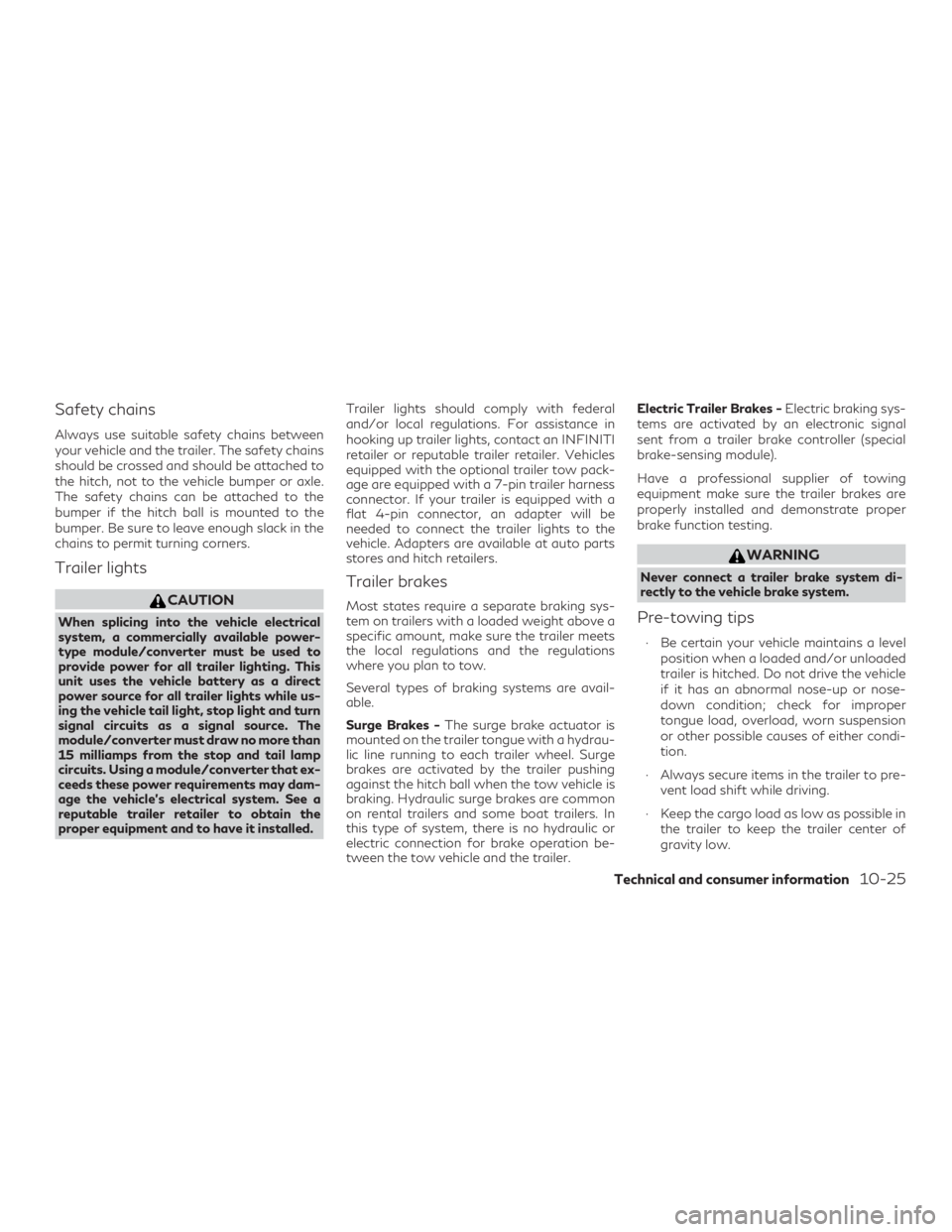
Safety chains
Always use suitable safety chains between
your vehicle and the trailer. The safety chains
should be crossed and should be attached to
the hitch, not to the vehicle bumper or axle.
The safety chains can be attached to the
bumper if the hitch ball is mounted to the
bumper. Be sure to leave enough slack in the
chains to permit turning corners.
Trailer lights
CAUTION
When splicing into the vehicle electrical
system, a commercially available power-
type module/converter must be used to
provide power for all trailer lighting. This
unit uses the vehicle battery as a direct
power source for all trailer lights while us-
ing the vehicle tail light, stop light and turn
signal circuits as a signal source. The
module/converter must draw no more than
15 milliamps from the stop and tail lamp
circuits. Using a module/converter that ex-
ceeds these power requirements may dam-
age the vehicle’s electrical system. See a
reputable trailer retailer to obtain the
proper equipment and to have it installed.Trailer lights should comply with federal
and/or local regulations. For assistance in
hooking up trailer lights, contact an INFINITI
retailer or reputable trailer retailer. Vehicles
equipped with the optional trailer tow pack-
age are equipped with a 7-pin trailer harness
connector. If your trailer is equipped with a
flat 4-pin connector, an adapter will be
needed to connect the trailer lights to the
vehicle. Adapters are available at auto parts
stores and hitch retailers.
Trailer brakes
Most states require a separate braking sys-
tem on trailers with a loaded weight above a
specific amount, make sure the trailer meets
the local regulations and the regulations
where you plan to tow.
Several types of braking systems are avail-
able.
Surge Brakes -
The surge brake actuator is
mounted on the trailer tongue with a hydrau-
lic line running to each trailer wheel. Surge
brakes are activated by the trailer pushing
against the hitch ball when the tow vehicle is
braking. Hydraulic surge brakes are common
on rental trailers and some boat trailers. In
this type of system, there is no hydraulic or
electric connection for brake operation be-
tween the tow vehicle and the trailer. Electric Trailer Brakes -
Electric braking sys-
tems are activated by an electronic signal
sent from a trailer brake controller (special
brake-sensing module).
Have a professional supplier of towing
equipment make sure the trailer brakes are
properly installed and demonstrate proper
brake function testing.
WARNING
Never connect a trailer brake system di-
rectly to the vehicle brake system.
Pre-towing tips
∙ Be certain your vehicle maintains a level position when a loaded and/or unloaded
trailer is hitched. Do not drive the vehicle
if it has an abnormal nose-up or nose-
down condition; check for improper
tongue load, overload, worn suspension
or other possible causes of either condi-
tion.
∙ Always secure items in the trailer to pre- vent load shift while driving.
∙ Keep the cargo load as low as possible in the trailer to keep the trailer center of
gravity low.
Technical and consumer information10-25
Page 556 of 580

∙ Load the trailer so approximately 60% ofthe trailer load is in the front half and
40% is in the back half. Also make sure
the load is balanced side to side.
∙ Check your hitch, trailer tire pressure, ve- hicle tire pressure, trailer light operation,
and trailer wheel lug nuts every time you
attach a trailer to the vehicle.
∙ Be certain your rearview mirrors conform to all federal, state or local regulations. If
not, install any mirrors required for tow-
ing before driving the vehicle.
∙ Determine the overall height of the ve- hicle and trailer so the required clearance
is known.
Trailer towing tips
In order to gain skill and an understanding of
the vehicle’s behavior, you should practice
turning, stopping and backing up in an area
which is free from traffic. Steering stability
and braking performance will be somewhat
different than under normal driving condi-
tions.
∙ Always secure items in the trailer to pre- vent load shift while driving. ∙ Lock the trailer hitch coupler with a pin or
lock to prevent the coupler from inadver-
tently becoming unlatched.
∙ Avoid abrupt starts, acceleration or stops.
∙ Avoid sharp turns or lane changes.
∙ Always drive your vehicle at a moderate speed.
∙ When backing up, hold the bottom of the steering wheel with one hand. Move your
hand in the direction in which you want
the trailer to go. Make small corrections
and back up slowly. If possible, have
someone guide you when you are back-
ing up.
Always block the wheels on both vehicle and
trailer when parking. Parking on a slope is not
recommended; however, if you must do so:
CAUTION
If you move the shift selector to the P
(Park) position before blocking the wheels
and applying the parking brake, transmis-
sion damage could occur. 1. Apply and hold the brake pedal.
2. Have someone place blocks on the
downhill side of the vehicle and trailer
wheels.
3. After the wheel blocks are in place, slowly release the brake pedal until the
blocks absorb the vehicle load.
4. Apply the parking brake.
5. Shift the transmission into P (Park).
6. Turn off the engine.
To drive away: 1. Start the vehicle.
2. Apply and hold the brake pedal.
3. Shift the transmission into gear.
4. Release the parking brake.
5. Drive slowly until the vehicle and trailer are clear from the blocks.
6. Apply and hold the brake pedal.
7. Have someone retrieve and store the blocks.
10-26Technical and consumer information
Page 557 of 580
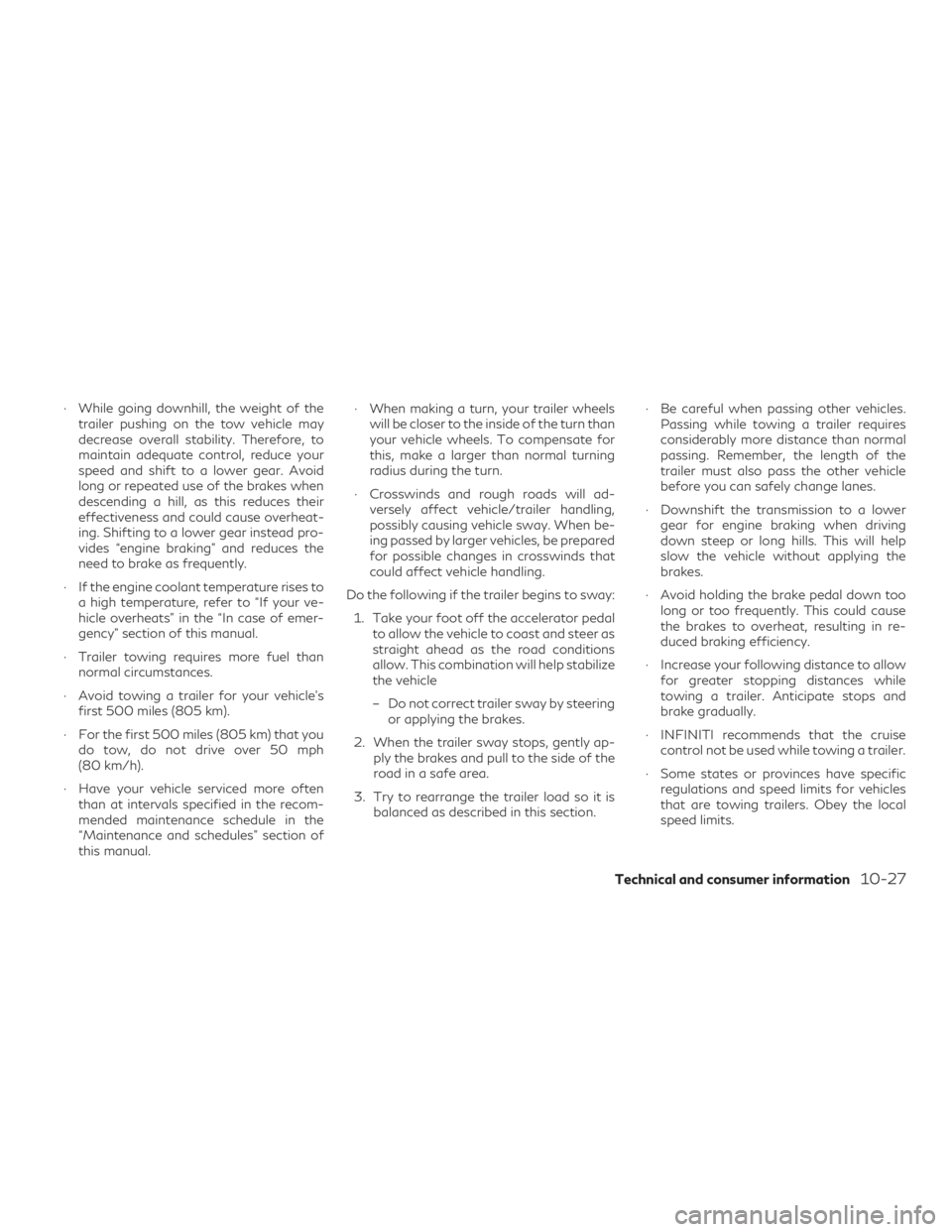
∙ While going downhill, the weight of thetrailer pushing on the tow vehicle may
decrease overall stability. Therefore, to
maintain adequate control, reduce your
speed and shift to a lower gear. Avoid
long or repeated use of the brakes when
descending a hill, as this reduces their
effectiveness and could cause overheat-
ing. Shifting to a lower gear instead pro-
vides “engine braking” and reduces the
need to brake as frequently.
∙ If the engine coolant temperature rises to a high temperature, refer to “If your ve-
hicle overheats” in the “In case of emer-
gency” section of this manual.
∙ Trailer towing requires more fuel than normal circumstances.
∙ Avoid towing a trailer for your vehicle’s first 500 miles (805 km).
∙ For the first 500 miles (805 km) that you do tow, do not drive over 50 mph
(80 km/h).
∙ Have your vehicle serviced more often than at intervals specified in the recom-
mended maintenance schedule in the
“Maintenance and schedules” section of
this manual. ∙ When making a turn, your trailer wheels
will be closer to the inside of the turn than
your vehicle wheels. To compensate for
this, make a larger than normal turning
radius during the turn.
∙ Crosswinds and rough roads will ad- versely affect vehicle/trailer handling,
possibly causing vehicle sway. When be-
ing passed by larger vehicles, be prepared
for possible changes in crosswinds that
could affect vehicle handling.
Do the following if the trailer begins to sway: 1. Take your foot off the accelerator pedal to allow the vehicle to coast and steer as
straight ahead as the road conditions
allow. This combination will help stabilize
the vehicle
– Do not correct trailer sway by steering or applying the brakes.
2. When the trailer sway stops, gently ap- ply the brakes and pull to the side of the
road in a safe area.
3. Try to rearrange the trailer load so it is balanced as described in this section. ∙ Be careful when passing other vehicles.
Passing while towing a trailer requires
considerably more distance than normal
passing. Remember, the length of the
trailer must also pass the other vehicle
before you can safely change lanes.
∙ Downshift the transmission to a lower gear for engine braking when driving
down steep or long hills. This will help
slow the vehicle without applying the
brakes.
∙ Avoid holding the brake pedal down too long or too frequently. This could cause
the brakes to overheat, resulting in re-
duced braking efficiency.
∙ Increase your following distance to allow for greater stopping distances while
towing a trailer. Anticipate stops and
brake gradually.
∙ INFINITI recommends that the cruise control not be used while towing a trailer.
∙ Some states or provinces have specific regulations and speed limits for vehicles
that are towing trailers. Obey the local
speed limits.
Technical and consumer information10-27
Page 558 of 580
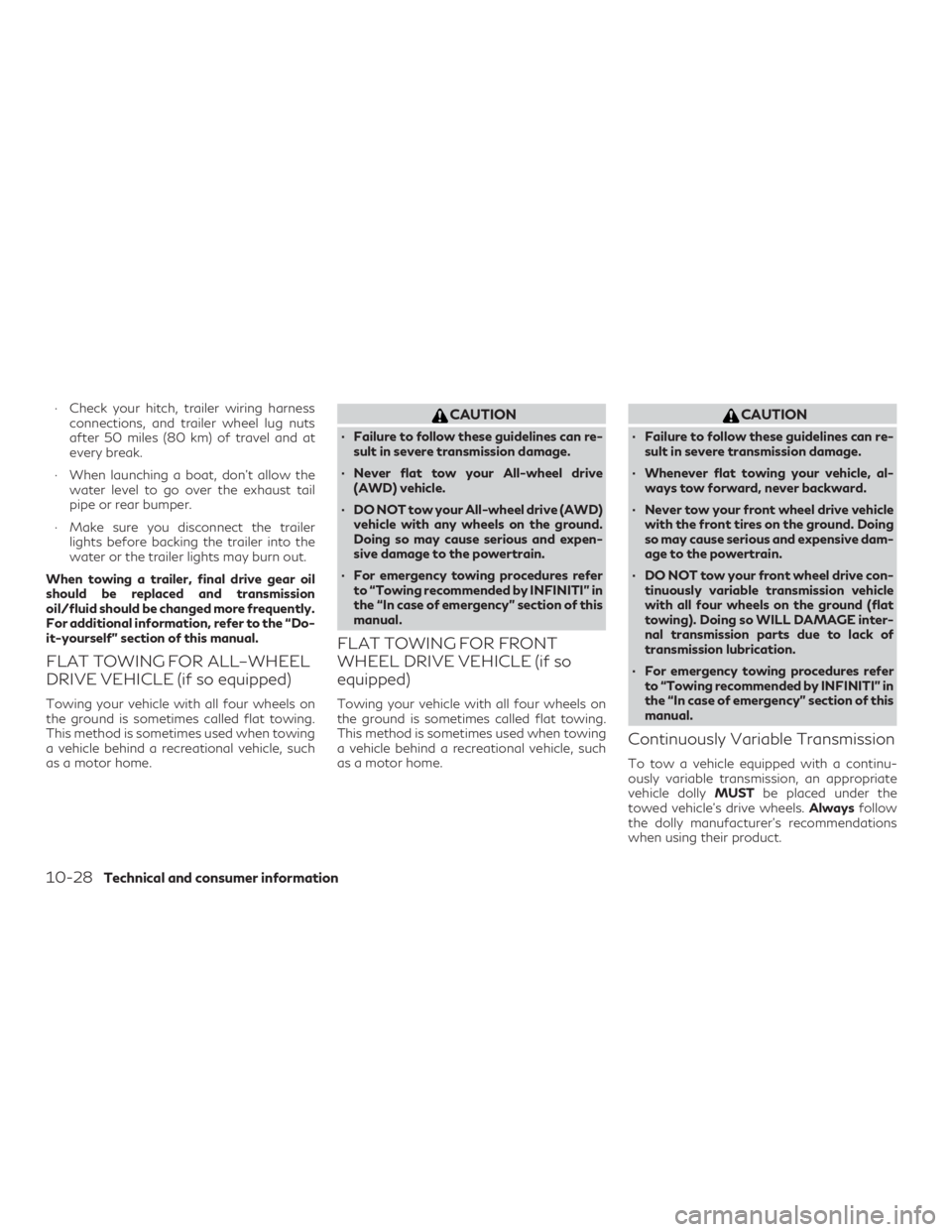
∙ Check your hitch, trailer wiring harnessconnections, and trailer wheel lug nuts
after 50 miles (80 km) of travel and at
every break.
∙ When launching a boat, don’t allow the water level to go over the exhaust tail
pipe or rear bumper.
∙ Make sure you disconnect the trailer lights before backing the trailer into the
water or the trailer lights may burn out.
When towing a trailer, final drive gear oil
should be replaced and transmission
oil/fluid should be changed more frequently.
For additional information, refer to the “Do-
it-yourself” section of this manual.
FLAT TOWING FOR ALL–WHEEL
DRIVE VEHICLE (if so equipped)
Towing your vehicle with all four wheels on
the ground is sometimes called flat towing.
This method is sometimes used when towing
a vehicle behind a recreational vehicle, such
as a motor home.
CAUTION
∙ Failure to follow these guidelines can re- sult in severe transmission damage.
∙ Never flat tow your All-wheel drive (AWD) vehicle.
∙ DO NOT tow your All-wheel drive (AWD) vehicle with any wheels on the ground.
Doing so may cause serious and expen-
sive damage to the powertrain.
∙ For emergency towing procedures refer to “Towing recommended by INFINITI” in
the “In case of emergency” section of this
manual.
FLAT TOWING FOR FRONT
WHEEL DRIVE VEHICLE (if so
equipped)
Towing your vehicle with all four wheels on
the ground is sometimes called flat towing.
This method is sometimes used when towing
a vehicle behind a recreational vehicle, such
as a motor home.
CAUTION
∙ Failure to follow these guidelines can re-sult in severe transmission damage.
∙ Whenever flat towing your vehicle, al- ways tow forward, never backward.
∙ Never tow your front wheel drive vehicle with the front tires on the ground. Doing
so may cause serious and expensive dam-
age to the powertrain.
∙ DO NOT tow your front wheel drive con- tinuously variable transmission vehicle
with all four wheels on the ground (flat
towing). Doing so WILL DAMAGE inter-
nal transmission parts due to lack of
transmission lubrication.
∙ For emergency towing procedures refer to “Towing recommended by INFINITI” in
the “In case of emergency” section of this
manual.
Continuously Variable Transmission
To tow a vehicle equipped with a continu-
ously variable transmission, an appropriate
vehicle dolly MUSTbe placed under the
towed vehicle’s drive wheels. Alwaysfollow
the dolly manufacturer’s recommendations
when using their product.
10-28Technical and consumer information